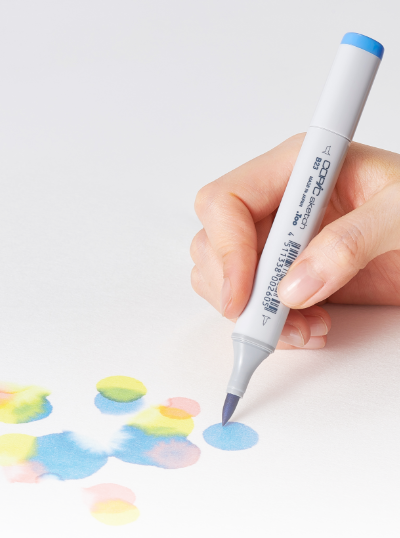Nature, Doodle Leaves
15-11-2022
Nature Series: How to doodle…
Today’s Feature: Leaves!

In our previous blog, we showed a new way to color and draw flowers with Copic markers and pens (the doodling technique). Today, we will be applying the same technique but with leaves! So, with that being said, let’s grab our markers and get started by swatching our colors below!

The first thing you want to do before coloring is to figure out your palette. For each of the different leaves I’ll be doodling, I tested out marker colors on a separate sheet of paper to be sure I’ve got an accurate palette. Notice that there are three different colors swatched for each leaf: a dark, a mid-tone, and a light. In the next step, I will choose to focus on the mid-tone color so the leaves aren’t too pale or too dark. However, you can choose the lighter or darker colors if you want!

The next step after swatching is to color in a motion that best expresses the shape of the leaf. This means coloring from the stem of the leaf outward in a straight or curved motion. Similarly to when you were swatching the leaf colors, we encourage you to have reference photos nearby while you complete this step as well. They’ll be a huge help in capturing the shape and color direction of the leaves accurately!

Once the coloring step is complete, the next step is to add the first outline layer using a Black Copic Multiliner pen. Simply trace over the leaves in a single pass/in one stroke to the best of your ability. For example, I was able to outline the stem of the chestnut without lifting my hand, along with the seven arms of the leaf body, because this leaf is composed of many smaller shapes. However, for simple leaves like the oak, ginkgo, sweetgum, birch, and aspen, try your best to complete each large outline without lifting your hand. But if you can’t, lift your hand at a joint/point where two lines meet so that it will be less noticeable that your hand was lifted up and placed back down again.
Notice too how in this step the outlining process isn’t exact. Some of the white paper is still showing through, and this is what the doodling technique is all about! To show off the beautiful imperfections of drawing and coloring by hand!
*Note: The Multiliner nib width I used above is 0.5.

After the initial outline is complete, the next step is to add details. Remember, your leaves don’t have to look realistic, so if you want to outline the birch veins, or draw disconnecting curved lines on the ginkgo leaf, feel free! The details added during this step using the Multiliner pen is a way to create depth to an otherwise flat layer of a single color.

Last but not least, the final step is to go over the outline of each leaf one more time with a thicker nib to create contrast with the details that were just added. In the above example, I was using 0.5 for the details and 0.8 for the final outline. However, this step is optional and all about preference! If you like the look of using the same nib width throughout, then you don’t have to add this final step to your doodles.

Now that we’ve gone through how to complete this doodling technique, let’s put our coloring skills to the test and apply them to this autumn wreath illustration found in the line art gallery on our website! Print the above 8.5 x 11 inch template at home on a sheet of paper suitable for markers. Then, swatch out the colors you want to use for each leaf type (all 12 leaves shown throughout the blog are included in this wreath).

Then, begin coloring the wreath, using the technique of coloring from the stem outward. Work quickly and outside the lines to achieve the expressive effect of a doodle. Leave some of the whites of the paper showing as well to exaggerate the marker streaks!
Once you’ve colored the wreath to your liking, you can frame this drawing, hang it up on your refrigerator, or gift it to a friend or loved one with a note on the back! Be sure to share your wreath and/or leaf doodles with us on social media using #CopicWithUs or tag us @copic_official_us.
—
Stay tuned for our next blog, where we’ll be showing you how to draw and outline trees with Copic Multiliner pens!
Read More Articles
Writing with Acrea, Pangrams
Greetings Copic readers! In our previous blog, we continued our introduction of writing with the new acrea marker by practicing our curs...

Writing with Acrea, Cursive Letters
Hello Copic readers! In our previous blog, we introduced writing with the new acrea marker by practicing our manuscript letterform...

Writing with Acrea, Manuscript Letters
Greetings Copic readers! In our previous blog, we compared the properties of Copic alcohol markers (Sketch, Ciao and Classic) with Copic...

Using Acrea and Copic Markers Together
Greetings Copic readers! In our previous blog, we compared the properties of Copic alcohol markers (Sketch, Ciao and Classic) with Copic...





